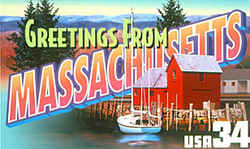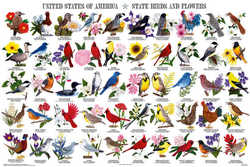
Massachusetts Symbols
Massachusetts State Bird
Black-Capped Chickadee (thrush)

(Parus atricapillus)
Adopted on March 21, 1941.
The Executive Board of the State Federation of Women's Clubs adopted the veery, (Hylocichla fuscescens,) a secretive thrush with a beautiful song, for their Massachusetts state bird in November 1931. A bill to designate the veery the official state bird was introduced in the legislature in the same year. It was not approved.
The Black-Capped Chickadee, (Penthestes atricapillus,) was adopted as the official Massachusetts State Bird by the Massachusetts Legislature on March 21, 1941. It is also known as the titmouse, tomtit, and the dickybird, and it is one of the most familiar of the North American birds.
The Black-capped chickadee,a bird almost universally considered "cute"thanks to its oversized round head, tiny body, and curiosity about everything, including humans and is the state bird of Maine and Massachusetts .
Massachusetts State Bird:
Black-capped
Chickadee

The Black-capped Chickadee brownish-black bill is short, straight and rounded. The Chickadee's glossy head is large with a short neck and dark brown eyes. Its body is thick. The feathers are blended and short. The Chickadee tail is long, arched, and rounded, with twelve slender feathers. Feet and claws are greyish-blue. he general coloring is ashy-grey, the back having a brownish tinge; the whole upper part of the head and the hind neck is pure black, as is a large patch on the throat and fore-neck. The Black-capped Chickadee is from four to five inches in size. It nests in a stump, tree, or fence post close to the ground, and broods twice a year. It is a cheerful bird and has a pleasing call: "Chick-adee-dee-dee".
Identification of the Black-capped Chickadee
- Length: 4.5 inches
- Short bill
- Black crown and throat
- White face
- Pale gray upperparts
- White edges to wing coverts
- Grayish-white underparts
- Rusty flanks
- Sexes similar
- Often found in small flocks
Black-capped Chickadees eat a variety of foods including insect eggs, ants, beetles, aphids, millipedes, snails, and other small creatures. They
also eat seeds of conifers, goldenrod, ragweed, and wild fruit. Black-capped Chickadees are not very picky at the feeder and will eat cornmeal, sunflower
seeds, suet, pumpkin seeds, and peanut butter.
Black-capped Chickadees prefer to live in mixed hardwood-coniferous forests. They also reside in small woodlands and shrubs by residential areas.
Both the male and female have similar plumage. Black-capped Chickadees have light gray backs and tails. They also have white bellies and cheeks. They
got the name "Black-capped Chickadee" because they have some black feathers on their heads that look like a cap. Black-capped Chickadees
also have some black feathers on their necks that look similar to a bib. In the winter, their sides are a deep brown.
Black-capped Chickadees survive the freezing weather by storing food they can use later in the season. Black-capped Chickadees can remember where they
stored seeds for up to eight months, which is more than enough time to get them through the winter.
Black-capped Chickadees also survive the winter by lowering their body temperatures at night, entering a state of controlled hypothermia. In essence,
they slow the blood flowing to the parts of their bodies they don't use while they are sleeping. This helps them save much-needed energy.
General Laws of Massachusetts
The law designating the Black-capped Chickadee as the official Massachusetts state bird is Section 9 of the General Laws of Massachusetts PART I
( ADMINISTRATION OF THE GOVERNMENT)
TITLE I (JURISDICTION AND EMBLEMS OF THE COMMONWEALTH, THE GENERAL COURT, STATUTES AND PUBLIC DOCUMENTS)
CHAPTER 2 (ARMS, GREAT SEAL AND OTHER EMBLEMS OF THE COMMONWEALTH)
SECTION 9.
PART I. ADMINISTRATION OF THE GOVERNMENT.
TITLE I. JURISDICTION AND EMBLEMS OF THE COMMONWEALTH, THE GENERAL COURT, STATUTES AND PUBLIC DOCUMENTS.
CHAPTER 2. ARMS, GREAT SEAL AND OTHER EMBLEMS OF THE COMMONWEALTH.
SECTION 9.
Chapter 2: Section 9 Bird or bird emblem of commonwealth
Section 9. The chickadee (Penthestes atricapillus) shall be the bird or bird emblem of the commonwealth
Taxonomic Hierarchy: Black-capped Chickadee
Kingdom: Animalia - animals
Phylum: Chordata - chordates
Subphylum: Vertebrata - vertebrates
Class: Aves - birds
Order: Passeriformes - perching birds
Family: Paridae - chickadees, titmice
Genus: Parus Linnaeus, 1758 - chickadees, titmice:
Species: Parus atricapillus Linnaeus, 1766 - black-capped chickadee







